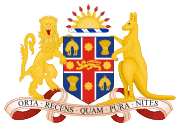Government of New South Wales facts for kids

Emblem of the New South Wales Government and its agencies
|
|

Coat of arms of the State of New South Wales, used for formal and ceremonial purposes.
|
|
| Formation |
|
|---|---|
| Australian state | New South Wales |
| Website | http://www.nsw.gov.au/ |
| Legislative branch | |
| Legislature | Parliament of New South Wales; |
| Meeting place | Parliament House |
| Executive branch | |
| Main organ | New South Wales Ministry |
| Leader | Premier |
| Appointer | Governor |
| Meeting place | Parliament House |
| Judicial branch | |
| Court | Supreme Court |
| Seat | Sydney |
The Government of New South Wales, also referred to as the New South Wales Government or NSW Government, is the Australian state democratic administrative authority of New South Wales, in Australia. The Government of New South Wales, a parliamentary constitutional monarchy, was formed in 1856 as prescribed in its Constitution, as amended from time to time. Since the Federation of Australia in 1901, New South Wales has been a state of the Commonwealth of Australia, and the Constitution of Australia regulates its relationship with the Commonwealth. Under the Australian Constitution, New South Wales ceded legislative and judicial supremacy to the Commonwealth, but retained powers in all matters not in conflict with the Commonwealth.
Section 109 of the Australian Constitution provides that, where a State law is inconsistent with a federal law, the federal law prevails (to the extent of the inconsistency). The New South Wales Constitution says: "The Legislature shall, subject to the provisions of the Commonwealth of Australia Constitution Act, have power to make laws for the peace, welfare, and good government of New South Wales in all cases whatsoever." Initially the Australian states retained significant independence. Over time, however, that independence has been greatly eroded by both the proliferation of Commonwealth Law, and the increasing financial domination of the Commonwealth.
Executive and judicial powers
New South Wales is governed according to the principles of the Westminster system, a form of parliamentary government based on the model of the United Kingdom. Legislative power rests with the Parliament of New South Wales, which consists of the Crown, represented by the Governor of New South Wales, and the two Houses, the New South Wales Legislative Council (the upper house) and the New South Wales Legislative Assembly (the lower house). Executive power rests formally with the Executive Council, which consists of the Governor and senior ministers.
The Governor, as representative of the Crown, is the formal repository of power, which is exercised by him or her on the advice of the Premier of New South Wales and the Cabinet. The Premier and Ministers are appointed by the Governor, and hold office by virtue of their ability to command the support of a majority of members of the Legislative Assembly. Judicial power is exercised by the Supreme Court of New South Wales and a system of subordinate courts, but the High Court of Australia and other federal courts have overriding jurisdiction on matters which fall under the ambit of the Australian Constitution.
In 2006, the Sesquicentenary of Responsible Government in New South Wales, the Constitution Amendment Pledge of Loyalty Act 2006 No. 6 was enacted to amend the Constitution Act 1902 to require Members of the New South Wales Parliament and its Ministers to take a pledge of loyalty to Australia and to the people of New South Wales instead of swearing allegiance to the Queen her heirs and successors, and to revise the oaths taken by Executive Councillors. The Act was assented to by the Queen on 3 April 2006.

